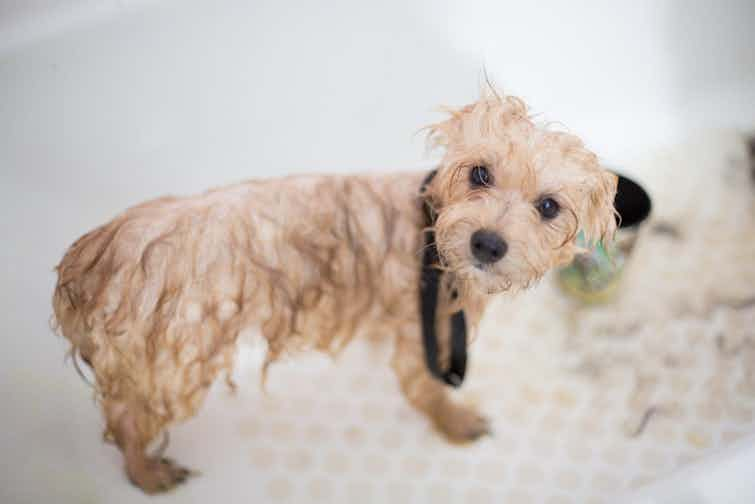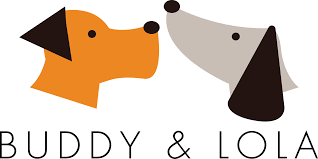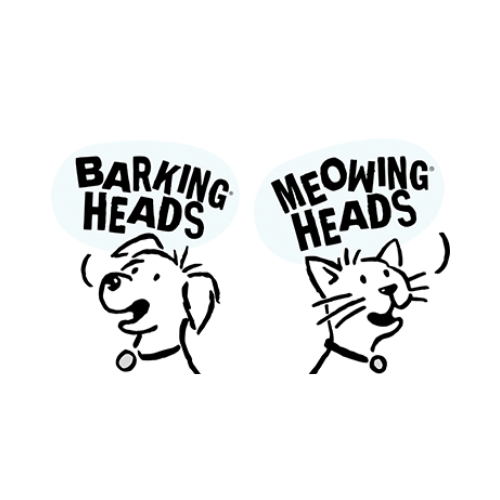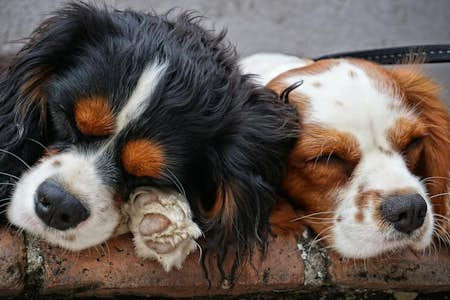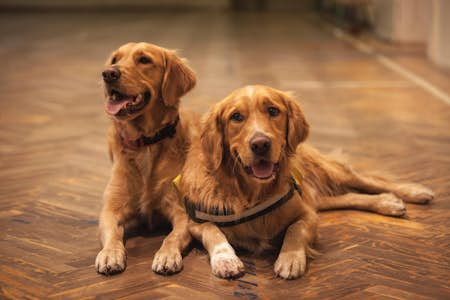Washing your dog too little or too often can greatly impact their health and the quality of the fur and skin. If your dog likes to be a little mischievous and rolls in something smelly, you may need to clean them a little more often than you’d like.
In this circumstance, unless you really need to use dog shampoo, you should use water and rinse the dirt out of your dog's fur occasionally rather than using dog shampoo every single time. This can help your dog’s fur retain some of its natural oils and won’t be potentially irritating sensitive skin as much as using shampoo every time.
Remember that even when you’re simply rinsing your dog, this could affect any flea and worming treatment drops, so you should reapply this when needed.
If you don’t wish to clean your dog at home, you can always take them to a professional groomer as often as your vet recommends.
Whether you're looking for a tailored diet solution for your furry friend or are looking for better value from your pet food shopping, our providers have various options to help meet your needs. Click a brand below to discover more of what they offer!
Factors to consider when bathing your dog
You should think about a few things when planning your dog's bathing routine and how regularly they need cleaning, as different breeds and lifestyles have individual requirements. Here are some of the things to consider:
Your dog's skin type and coat type
One of the main things to consider when you’re looking to bathe your dog is their coat type and skin type. Whether your dog’s fur is curly or straight, long or short, prone to matting or not, can all have a huge difference in what your typical bathing routine should involve. Long-haired or curly-haired dog breeds will usually need to be bathed and groomed more regularly as their fur will be more prone to matting. Usually, the recommendation for this type of dog is bathing them once every four to six weeks, with regular grooming such as brushing in between. Short-haired dogs generally can go longer without being bathed as long as they have no health requirements and are relatively clean.
Any allergies or health requirements
Certain skin conditions or allergies can have an effect on how often you should bathe your dog and potentially on what type of shampoo you should be using, such as medicated shampoo. You should consult your vet if you’re concerned about your dog’s skin when it comes to bathing, especially if you are aware of any health issues.
Your vet may also recommend certain hypoallergenic or soothing shampoos if your dog has dry or itchy skin; oatmeal shampoo is a popular product.
Activity levels and general exercise routines
Working dogs and extremely active dogs will generally need more baths than regular indoor dogs. Consistent dog bathing will help control body oils and odours for pooches who are always on the move.
Your own sanity and comfort
If your dog is likely to roll in things or somehow finds a muddy puddle on every single walk to jump into, bathing your dog more often might be a good thing for your own sanity as long as it doesn’t affect your dog's skin or fur. You might also need to consider any of your own allergies or sensitivities to your dog's dander, and frequent baths or brushing may help you breathe easier.
What about hairless dogs?
Hairless dogs are quite rare, but they do generally have very different bathing requirements. We’d recommend speaking to your vet about your dog's specific needs, but usually, dogs without fur require regular bathing weekly as they do not have the skin protection that a coat provides.
How to bathe a dog
You can bathe your dog in many different ways, from using your bathtub to using a hose outdoors or even taking them to a professional groomer. If you’re wanting to start bathing your dog at home, here is a basic routine that should help you get started in figuring out how to bathe your dog:
Start by gathering everything you need for bath time. Ensure you have brushes, towels, dog shampoo, washcloths, and anything else you hope to use. It may also be helpful to have a leash and collar that you don’t mind getting wet, this can help keep your dog under control, especially if they get overly excited. You might also want to get things like treats for positive reinforcement or a lick mat for any nervous dogs to keep them distracted.
You should make sure your bath has a non-slip mat or something to help keep your dog steady on all fours.
If you have a small dog that is light enough for you to lift into the bathtub, you can do this on your own. If your dog is a bit larger or heavier, you may want to get some help to lift them into the tub or teach your dog to climb in by themselves. If you’re teaching your dog to jump in the bath themselves, be extremely careful of any potential slipping.
You should use lukewarm water to clean your dog, the same water temperature you’d use for a baby, not too hot and not too cold. Make sure to test the water before you use any of it on your dog. We’d suggest using your forearm or elbow as your hands sometimes react differently to extreme temperatures.
Begin by slowly covering your dog's fur with water, taking extra care around their eyes and ears. If you want to clean your dog’s ears, you should do this before or after bath time to make sure you avoid getting any dog shampoo in your dog's ears. You can clean their ears with damp cotton balls, a dog-safe ear cleaner, or a towel.
Use your chosen dog shampoo and lather this on your dog’s fur. If your dog has an undercoat, be sure to massage the shampoo into their fur enough to get through to clean their undercoat. You can use a gentle washcloth for this if you’d prefer not directly using your hands; usually best if you’re cleaning your dog after they’ve rolled in something they shouldn’t have.
Ensure you rinse your dog clean of any shampoo, as leaving it in their fur can dry out your dog’s skin.
Start drying your dog by slowly and gently squeezing water from the fur by applying pressure to their body, don’t pull too much on their fur to dry them. You can then grab your towel and begin towel drying them.
You can use a blow dryer or hairdryer on low heat to dry your dog, but this can make many dogs nervous due to the noise. Towel-drying your dog or taking them outside on a warm day to air-dry is a good alternative to this.
Make sure to brush your dog after they’ve been dried to brush out any tangles in their fur.
How do I know when my dog needs a bath?
Knowing when to bathe your dog can be difficult if your pup isn’t particularly active or smelly, so here are a few signs to look out for to decide when you might need to clean your dog:
- A strong odour
- Your dog is scratching and licking themselves often
- Their coat is dirty
- Your dog has red skin or signs of irritation
- Their coat is shedding more than usual
- There is matting in their fur
Bath training for dogs who hate baths
Some dogs may really struggle with bath time, this can be due to anxiety or simply over-excitement. It might be helpful for you to get someone else to help you with bathing your dog, as they can provide treats and positive reinforcement while you are busy washing your dog. If you don’t have anyone to help you, try using something like a lick mat or other food puzzle to keep your dog busy while you focus on cleaning them. This can really help keep a dog calm during bath time, especially if it is their first time in the tub.
You can try a few other things to help your dog during bath time. Here are some tips:
Take your dog into the bathroom without any intention of bathing them, and get them used to being in the room with no negative experiences. Once they’re comfortable with this, try placing them into the tub and letting them leave without washing them. This helps get your pup comfortable with the experience before you even try to wash them.
Once your dog is happy enough in the room, you can try introducing water. Don’t go straight in with a full bathing routine, just try some simple water and towel drying at first.
If you have a high-pressure shower head, you might want to try a light sprayer instead, as this will be less intimidating for your pup.
Using a lick mat, food puzzle, or toys to keep your dog busy can be a great way to distract them if they get nervous during bath time.
If your dog still really hates the bathtub, you could try using a hose outdoors in your garden in warm weather. This may be a messier option, and you have to avoid areas with grass as your dog will just end up getting muddy, but if you’re really struggling to clean your dog, this can be a good option in between grooming visits.
Can you bathe a dog too much?
Everyone would love to have a fresh-smelling, clean dog all the time. But you could be bathing your dog too often, which could be detrimental to their health. Bathing your dog too much can negatively affect their coat and skin, as it can strip them of their natural oils and dry out their skin, potentially causing irritation and skin conditions.
You should always discuss your dog's grooming and bathing requirements with your vet, as you’ll need to consider their skin type, coat type, and breed. There are other ways to keep your dog smelling fresh and clean in between baths if you’re worried about overdoing it on cleaning.
If your dog is getting dry skin and you aren’t bathing them too regularly, you may also need to consider a different type of shampoo. You should never use human shampoo on your dog, but different dog shampoos have different features. For dogs who tend to have dry or sensitive skin, specific dog shampoos help moisturise their skin as it’s cleaned.
Not all signs of dry skin or non-shiny dog fur will be due to bathing, it could also be due to dog food and nutrition requirements.
Other dog hygiene tips
There are plenty of other dog grooming and hygiene tips for dog owners to be following outside of the bathing routine. Here are some other things you should be adding to your dog care routine to make sure your doggie is getting all of the grooming they need:
Make sure you’re taking care of your dog's dental health
Dental health in dogs can be something which gets overlooked far too often. Ideally, dogs should have their teeth brushed daily, but even a few times a week can hugely improve their dental hygiene. You should use dog-safe toothpaste, as human toothpaste may contain ingredients that could make your dog sick if they were to swallow it. Some types of dog toothpaste also have specific flavours to encourage your dog to enjoy the experience, so these can be useful if you struggle to keep up with your dog's dental routine. There are also dog groomers who specialise in teeth cleaning, so getting an occasional check-in for this can help keep your dog’s dental health in top condition.
Regularly brush your dog
You might not always need to bathe if your dog is shedding a lot or is dirty. Simply brushing your dog can help refresh their coat and dislodge any dirt caught up in their fur. Brushing also helps dispense the natural oils built up in your dog’s coat, making it shinier and healthier looking. Brushing can also help avoid any tangles or matting. Certain dog breeds will need much more regular brushing than others. For example, dogs with long hair or curly hair may need brushing on a daily basis.
There are also many different brushes for all your dog’s type of coat needs, so make sure you’re using the correct type of brush for your dog’s hair. You can speak to your vet for more information on what is best for you to use and to discuss how often you should be brushing your dog.
Cleaning up eye goop
Eye goop is something every dog gets, especially for certain breeds such as pugs or French bulldogs. It isn’t pretty but is easily dealt with, you can simply use a warm cloth to wipe away the discharge from your dog’s eyes.
Cleaning your dog's ears
Keeping your dog’s ears clean can be hugely important for their health as it helps avoid infections. You can use warm water and cotton pads to do this, and dog-safe ear-cleaning solutions are also available for extra help. You should avoid using cotton swabs as this can push things further into your dog’s ears, potentially causing more harm than good.
Trim your dog’s nails
Depending on how active your dog is, you may need to trim their nails more often. You can either do this yourself at home or if your dog is particularly difficult during this time, you can work with a professional groomer. If your dog is reactive when getting their nails trimmed, you may need to discuss other options with your vet or groomer.
Keep your pup's face clean
You can use a damp, gentle washcloth to wipe away any dirt that builds up on your dog’s face. Some dogs may get their face dirty more often than their body, so they don’t need a full bath time clean-up, but they do need a quick face clean to wash away any debris or bacteria. If your dog has wrinkles in their skin, they may need regular face cleaning.
Do dogs like baths?
Whether dogs do or don’t like baths can completely depend on the dog and their bath time experience. Some dogs can be extremely anxious when bathing, and some dogs will try to jump in the tub when you’re running a bath for yourself.
Many dogs will have a burst of energy after a bath, so this is something to keep in mind if you aren’t used to bathing your dog yet. They often have a lot of excitement or anxiety to burn and can run around shaking a lot to get dry, so make sure you dry them as much as possible before letting them loose in your home.
Dogs can have many different reactions to bath time, but if you take the time when they’re younger to train them, bathing your dog doesn’t have to be complicated.
Image Credit: Benjamin Lehman at Pexels

